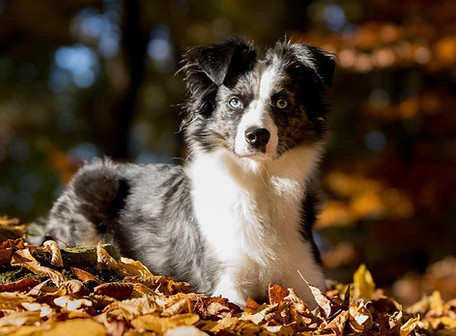
Colors and Patterns
Genetics Basics for Australian Shepherds Colors and Traits
Before diving into the amazing world of coat colors and patterns, it helps to understand a few key concepts about genetics. Don’t worry—it’s simpler than it sounds!
🔹 What Is a Locus?
-
A locus (plural: loci) is like a specific address or location on a chromosome.
-
Each locus holds genes that control a certain trait—like coat color, pattern, or texture.
-
Think of a locus like a mailbox for a particular genetic instruction—say, the K locus handles whether a dog is solid black or patterned.
🔹 What Is an Allele?
-
An allele is a version of a gene found at a specific locus.
-
Every dog has two alleles at each locus—one from their mom and one from their dad.
-
The combination of those two alleles is what determines how that trait shows up.
For example: At the B locus (which controls black or brown pigment), a dog might inherit a B from dad and a b from mom. Since B is dominant, the dog will appear black, even though it carries brown.
How Does Inheritance Work?
Every parent contributes one allele per locus to their puppies. The interaction between the pair of alleles the puppy inherits determines how each trait is expressed.
Types of genetic expression:
-
Dominant – Only one copy is needed to show the trait.
-
Recessive – Two copies are needed (one from each parent).
-
Incomplete or Co-dominant – Both alleles influence the trait, often seen as blending or mottling (like merle).
Example Breeding: Black Tri × Red Merle
Let’s say we’re breeding two typical Australian Shepherds:
Black Tri Female:
-
Genotype (example): At/At (tan points), ky/ky, B/B (black), E/E (normal pigment), m/m (non-merle carrier), D/D (non-dilute)
Red Merle Male:
-
Genotype (example): At/At (tan points), ky/ky, b/b (liver), E/E, M/m (merle), D/D (non-dilute)
Possible Puppies:
-
E Locus (Pigment allowed):
All puppies will be E/E, allowing for black or liver pigment to show. -
B Locus (Black or Liver):
All puppies will be B/b. They’ll appear black (tri or merle), but carry liver. -
M Locus (Merle):
-
50% chance of M/m → Merle-coated puppies
-
50% chance of m/m → Non-merle puppies
-
Safe Pairing Note: This combo avoids producing double merles (M/M), which are at high risk for hearing and vision issues.
-
A Locus + K Locus (Pattern):
All puppies are At/At and ky/ky, so tan points will be expressed.
Expected Phenotypes:
-
Black Tri (m/m, B/b)
-
Blue Merle (M/m, B/b)
Note: All pups will carry liver (b). This is referred to as being “Red Factored.” Red factored dogs are valuable in breeding programs because they can produce either black or red (liver-based) offspring when paired appropriately. This expands future color possibilities in your lines.
The Genetic Palette
When you mix together all the genetic loci—B, E, K, A, M, D, S, G, I—you get a vibrant and unique combination in every pup. Each layer of genetics builds on the last, like brushstrokes in a masterpiece.
Even from the same parents, no two puppies may look alike. One litter could contain:
-
A black tri,
-
A blue merle,
-
A black tri carrying liver,
-
A blue merle with bright copper,
-
Or one with minimal white.
That’s the wonder of Aussie genetics: beautifully complex, yet entirely predictable with the right knowledge.
Key Takeaways
-
"Red" Aussies are liver-colored (b/b), not recessive red (e/e).
-
Merle is a modifier of eumelanin, creating the marbled “blue” or “red” merle look.
-
Pattern (tan points, sable) is controlled by the A locus, but only visible if K is ky/ky.
-
Predicting coat colors requires knowing both genotype and how loci interact.















_edited.jpg)







